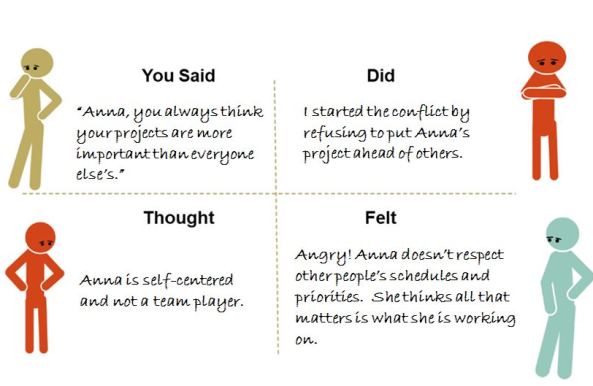
Conflict Management Tool
At one time or another, you or your employees will face conflict. Conflict is a part of life. When it happens, resolution usually requires some kind of face-to-face meeting. What is the best way to prepare for a meeting like this? What can be done to set the right tone and show that you have come prepared to find a win/win solution?
One idea is to use an Empathy Quadrant. This tool provides a practical way to put yourself in the other person’s shoes and anticipate what they might be thinking and feeling. (Of course, there is no way to know for sure; the idea is to prepare for the face-to-face meeting by trying to see the conflict from the other person’s perspective, in addition to your own.)


Empathy Quadrants are pretty straightforward. When completing one, the greatest challenges are being honest with yourself about the part you've played in the conflict, and putting your position aside long enough to reflect genuinely on what the other person might be thinking and feeling.
Empathy Quadrant Instructions
To use the Empathy Quadrant:
1. Think about the conflict and your part in it.
2. Write down what you said and did, what you were thinking and how you felt.
3. Think about the other person.
4. Write down what the other person said and did.
5. Consider what the other person might have thought and how the other person might have felt. Write that down as well.
6. Use your potential insights to prepare for your face-to-face meeting.
• Think about how the other person’s perspective impacts the conflict and its possible resolution.
• How can your potential insight about what the other person may be thinking or feeling help you prepare for your meeting? If you were in the other person’s shoes, how would you want to be approached?
• What do you anticipate will happen? Is there anything you can you do to avoid any possible problems?
Example of Using an Empathy Quadrant
To illustrate the tool's use, here is a sample conflict scenario and corresponding Empathy Quadrant.
Sample Scenario:
You are a busy marketing person with many projects on tight deadlines for the Sales team, in addition to company-wide product launches. You've just had an argument with Anna, a member of the sales team. Anna wants you to focus on her project and complete it by Friday. You told her Friday is impossible because a new product campaign is your priority this week.
You are already under pressure to meet your Friday deadline, and you’re frustrated because Anna thinks her job is more important than yours. When you tell her that, she says she has a large sale riding on details that only you can provide. She doesn’t understand why you can’t slip in her request; she doesn’t think it will take long. This isn’t the first time she has made unreasonable demands of you. She agreed to meet in the morning to discuss the problem.
The Empathy Quadrant you create in preparation for your meeting with Anna might look something like this:




- How might this perception of Anna’s perspective impact your current conflict and potential resolution?
- How might insights like this about how Anna is feeling help you prepare for a face-to-face meeting?
- After thinking about both sides of this conflict, what issues do you anticipate might arise in the meeting? Is it possible to come to the meeting prepared to work through them?
Download the Empathy Quadrant Worksheet and instructions.
Respectful conflict resolution is one sign of a positive company culture.
For more on respect at work, see:
How Was Your Day?
Getting Real about Bias, Diversity and Inclusion, and Harassment
Uncomfortable Conversations
Workplace Communication Training for Managers









